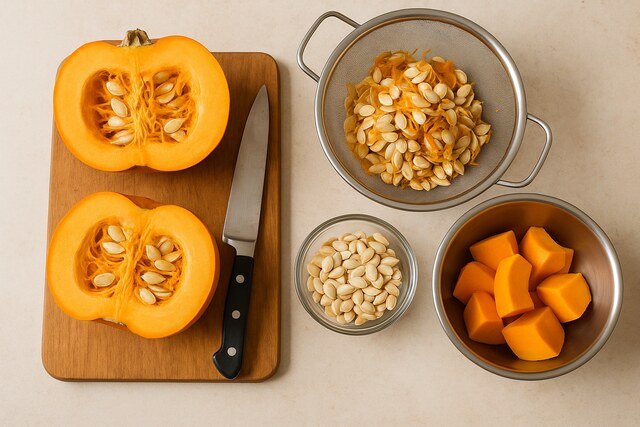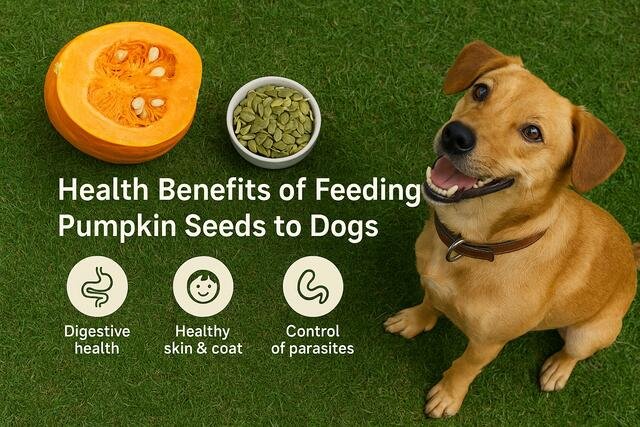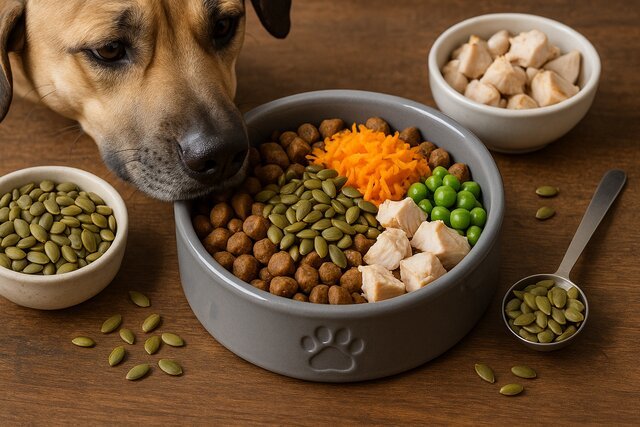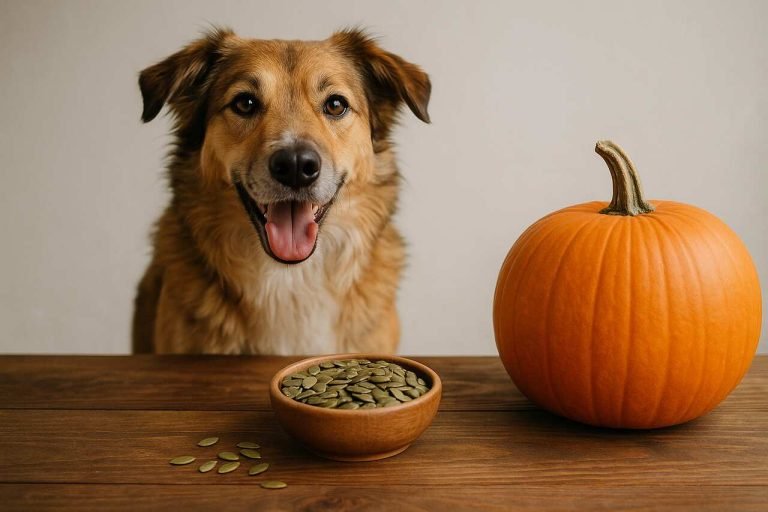Introduction
Pet owners often look for nutritious, natural snacks that can complement their dog’s diet. Among the many options, pumpkin seeds have gained attention as a possible healthy treat. The question, however, remains: can dogs eat pumpkin seeds safely? Understanding the nutritional profile, benefits, potential risks, and correct preparation methods of pumpkin seeds is crucial before offering them to your furry friend. This guide explains everything about feeding pumpkin seeds to dogs, from portion sizes and preparation to health benefits and storage safety, ensuring your pet enjoys them without harm.
Evaluate the Nutritional Value of Pumpkin Seeds for Dogs
Pumpkin seeds are nutrient-dense and packed with vitamins, minerals, and essential fatty acids that can contribute to your dog’s overall well-being. They are an excellent source of zinc, magnesium, iron, and healthy fats that support skin, coat, and immune health. Moreover, the antioxidants in pumpkin seeds can help reduce inflammation and improve cellular repair. When offered in moderation, these seeds can become a beneficial addition to a balanced canine diet.
Beyond macronutrients, pumpkin seeds also contain amino acids such as tryptophan, which promotes calmness and better sleep patterns in dogs. The omega-3 and omega-6 fatty acids play vital roles in supporting brain function and joint flexibility. These benefits, however, depend on serving the seeds in appropriate quantities without added salt, sugar, or oil, which can otherwise upset your dog’s digestive system.
Feeding pumpkin seeds should be viewed as a dietary enhancement rather than a staple food. Always ensure that seeds are plain, unsalted, and shelled properly before consumption. Overfeeding can lead to gastrointestinal distress or obesity due to the calorie density of these seeds.
Key Nutrients Found in Pumpkin Seeds
| Nutrient | Function in Dogs | Benefit |
| Zinc | Supports immune and skin health | Reduces shedding and skin irritation |
| Magnesium | Regulates nerve and muscle function | Helps prevent cramps |
| Omega-3 Fatty Acids | Maintains coat and brain health | Promotes shiny fur |
| Iron | Aids oxygen transport | Prevents fatigue |
Comparing Pumpkin Seeds to Other Dog Treats
Pumpkin seeds provide more micronutrients than many commercial dog treats, which often rely on fillers and artificial preservatives. Unlike biscuits or processed snacks, natural seeds contain no additives and offer trace minerals essential for long-term vitality.
Prepare Pumpkin Seeds Safely Before Feeding

Before feeding pumpkin seeds to dogs, preparation is essential to remove potential hazards. Always start by washing raw seeds thoroughly to eliminate residual pumpkin flesh. After cleaning, roasting them without any seasoning, salt, or oil ensures they remain safe and digestible. Never feed flavored or pre-packaged pumpkin seeds meant for human consumption, as they often contain spices or sodium that are toxic to dogs.
Grinding the seeds into powder form can help smaller dogs or puppies digest them more easily. The powder can be sprinkled over dog food or mixed with wet meals for better absorption. For larger breeds, lightly roasted and shelled whole seeds can be offered as an occasional crunchy treat.
Storing prepared pumpkin seeds correctly maintains freshness and nutrient integrity. Place them in an airtight container and store in a cool, dry place. Refrigeration can prolong shelf life up to two months, reducing the risk of mold or rancidity.
Step-by-Step Guide to Preparing Pumpkin Seeds
- Scoop fresh seeds from a pumpkin.
- Rinse thoroughly and pat dry.
- Spread evenly on a baking sheet.
- Roast at 300°F for 10–15 minutes (no oil or salt).
- Cool completely before serving or grinding.
Common Mistakes to Avoid When Preparing Seeds
Many pet owners unintentionally harm their dogs by offering salted or seasoned seeds. Others skip the drying process, which may cause bacterial growth. Always avoid flavored, candied, or spiced versions, and ensure proper roasting time to maintain safety and palatability.
Determine the Correct Portion Size for Different Dog Breeds
The amount of pumpkin seeds a dog can safely eat depends on size, weight, and health condition. For small dogs, one or two seeds per day are usually sufficient. Medium breeds can enjoy up to five seeds, while large dogs may have up to ten. These portions help prevent calorie overload while still delivering health benefits.
Adjusting portion sizes according to your dog’s activity level and age is also vital. Puppies, for instance, require fewer calories from fats, while active adult dogs can metabolize them more efficiently. For overweight or sedentary pets, pumpkin seeds should be limited to avoid unnecessary fat accumulation.
Excessive consumption may result in diarrhea or gastrointestinal upset. Introduce seeds slowly into your dog’s diet and monitor for allergic reactions such as itching, swelling, or vomiting.
Recommended Pumpkin Seed Portions by Dog Size
| Dog Size | Ideal Serving | Frequency |
| Small (under 20 lbs) | 1–2 seeds | Once daily |
| Medium (20–50 lbs) | 3–5 seeds | Once daily |
| Large (over 50 lbs) | 6–10 seeds | Once daily |
Adjusting Portions for Special Health Conditions
Dogs with pancreatitis, kidney issues, or dietary fat restrictions should consume smaller amounts or avoid seeds entirely. Consult a veterinarian before introducing pumpkin seeds to ensure compatibility with your dog’s specific health needs.
Identify the Health Benefits of Feeding Pumpkin Seeds to Dogs

Pumpkin seeds offer multiple health benefits when fed properly. They are rich in natural antioxidants that fight free radicals, supporting a stronger immune system. Their high zinc and vitamin E content aids in skin regeneration, promoting a shiny coat and reducing itching or dryness. Additionally, the fiber in pumpkin seeds helps regulate digestion and prevents constipation.
One of the most notable benefits is their natural deworming property. Compounds like cucurbitacin in pumpkin seeds can paralyze intestinal parasites, helping dogs eliminate them naturally. This makes pumpkin seeds a safe, holistic alternative to chemical dewormers for mild infestations.
Furthermore, omega fatty acids and magnesium support heart health and reduce inflammation in joints. Regular inclusion of small amounts can contribute to long-term vitality and better mobility, particularly in aging dogs.
Digestive and Antiparasitic Effects
Cucurbitacin, a bioactive compound in pumpkin seeds, disrupts the nervous system of intestinal worms, making them detach from the intestinal walls. Feeding small amounts regularly can act as a preventive measure against parasites like tapeworms and roundworms.
Skin, Coat, and Immune System Benefits
The combination of zinc, vitamin E, and antioxidants enhances cellular regeneration. Dogs consuming pumpkin seeds often exhibit shinier coats, reduced hair loss, and fewer skin irritations, especially during seasonal changes.
Recognize Potential Risks and Side Effects
Despite their benefits, pumpkin seeds can pose risks if consumed improperly. Overfeeding may cause stomach upset, vomiting, or diarrhea. Their high fat content, though healthy in moderation, can contribute to pancreatitis in susceptible dogs. Additionally, old or rancid seeds may produce harmful toxins that affect liver function.
Another concern arises from flavored or salted seeds. Sodium and artificial seasonings are toxic to dogs and can lead to dehydration or increased blood pressure. Feeding unroasted seeds also risks bacterial contamination such as salmonella, especially if seeds are not stored correctly.
Pet owners must observe their dogs closely after introducing any new treat. Symptoms like bloating, lethargy, or itching indicate potential intolerance or allergic reaction, requiring immediate discontinuation and veterinary consultation.
Signs of Pumpkin Seed Overconsumption
Common symptoms include loose stool, excessive gas, decreased appetite, or abdominal discomfort. These signs usually resolve after stopping the seeds, but persistent issues require professional care.
When to Contact a Veterinarian
Seek immediate veterinary help if your dog shows vomiting, swelling, or breathing difficulties after eating pumpkin seeds. Severe allergic reactions or acute pancreatitis can develop rapidly in sensitive dogs.
Incorporate Pumpkin Seeds into Daily Dog Meals

Integrating pumpkin seeds into your dog’s diet can be done creatively without disrupting meal balance. You can sprinkle ground seeds over dry kibble or mix them with wet food. Combining them with pumpkin puree creates a nutrient-rich blend ideal for digestive support.
Treat recipes like homemade dog biscuits can also include ground pumpkin seeds for added nutrition. However, keep the overall calorie count in mind to prevent weight gain. Always measure accurately and adjust according to daily caloric requirements.
To maintain dietary variety, rotate pumpkin seeds with other safe natural snacks such as carrots, apple slices, or blueberries. This ensures balanced nutrient intake and prevents monotony in your dog’s feeding routine.
Creative Ways to Add Pumpkin Seeds to Dog Meals
- Mix ground seeds with plain yogurt.
- Sprinkle on top of kibble.
- Blend into homemade dog treats.
- Combine with pumpkin puree for fiber boost.
Balancing Pumpkin Seeds with Other Supplements
If your dog already consumes fish oil or other omega supplements, adjust pumpkin seed portions accordingly. Excess fat can strain the pancreas or liver. Consulting your vet ensures all nutritional elements remain balanced.
Store and Preserve Pumpkin Seeds Properly
Proper storage of pumpkin seeds ensures they remain safe and fresh for your dog. Exposure to heat or moisture can cause mold growth and nutrient loss. Store seeds in airtight containers and keep them in a cool, dark place away from sunlight.
Freezing is another effective way to preserve freshness for long periods. If storing roasted seeds, allow them to cool fully before sealing to prevent condensation, which promotes spoilage. Label containers with preparation dates for easy rotation and monitoring.
Avoid plastic bags for long-term storage as they trap moisture and encourage mold. Glass jars or stainless-steel containers are better for maintaining quality and preventing odor transfer.
Storage Guidelines for Maximum Freshness
| Storage Type | Shelf Life | Notes |
| Room Temperature | Up to 1 month | Keep in airtight jar |
| Refrigerated | Up to 2 months | Prevents rancidity |
| Frozen | Up to 6 months | Ideal for bulk batches |
Detecting Spoiled or Unsafe Pumpkin Seeds
Spoiled seeds emit a sour or oily odor and may appear discolored. Discard immediately to prevent foodborne illness. Feeding spoiled seeds can cause vomiting, diarrhea, and fatigue in dogs.
Monitor Your Dog’s Reaction and Adjust Accordingly
After introducing pumpkin seeds, observe your dog’s response over several days. Monitor stool consistency, appetite, and overall energy levels. A positive response usually manifests as improved digestion and healthier coat shine. Negative reactions indicate that the portion may be too large or that seeds are unsuitable for your pet.
Adjust frequency or quantity gradually based on tolerance. Remember that every dog’s metabolism differs, and what suits one may not suit another. Use pumpkin seeds as part of a larger nutritional strategy rather than a replacement for complete meals.
Tracking your dog’s reactions can help build a personalized feeding plan that includes diverse whole-food ingredients for optimal health.
Behavior and Digestive Indicators to Watch
Improved stool texture, brighter eyes, and increased vitality indicate good tolerance. Conversely, gas, fatigue, or digestive irregularities suggest the need to reduce or eliminate seeds.
Long-Term Integration in a Balanced Diet
Over time, moderate inclusion of pumpkin seeds can support long-term health when paired with high-quality protein and fiber sources. Always prioritize moderation and periodic breaks from the same treat to maintain variety.
Conclusion
Pumpkin seeds can be a nutritious, safe, and beneficial addition to a dog’s diet when prepared and served correctly. Rich in essential minerals, healthy fats, and natural antiparasitic properties, they support digestive health, skin, and coat vitality. However, moderation, proper preparation, and careful observation are key. Always introduce seeds gradually, choose unsalted and plain varieties, and store them properly to retain their nutritional value. By following these steps, you can confidently include pumpkin seeds as a wholesome treat that enhances your dog’s overall wellness.
Explore more insightful and valuable content on our blog VeoTag.com! Stay updated with helpful tips, expert advice, and in-depth articles that enhance your knowledge.
Read Also:
- The Surprising Uses of Sunflower Oil for Dogs
- Monster High Characters: Explore the Iconic Ghouls, Their Stories
- KBH Games: Explore, Play and Master Free Online Games
- Halloween Jokes for Adults: The Ultimate Guide to Spooky Laughter
FAQ’s
Raw pumpkin seeds can harbor bacteria and should be roasted before feeding. Lightly roasted seeds are safer and easier to digest.
You can give small amounts daily, depending on your dog’s size. Follow portion guidelines and monitor for any digestive changes.
They can help prevent mild infestations but should not replace prescribed deworming treatments. Use them as a natural supplement only.
Yes, salted seeds can cause dehydration and sodium toxicity. Always use unsalted, plain varieties.
Puppies can have finely ground pumpkin seeds in small amounts after consulting a vet. They are more sensitive to fats and portion size.
Yes, the zinc and omega fatty acids in pumpkin seeds support skin health, which can reduce excessive shedding over time.

